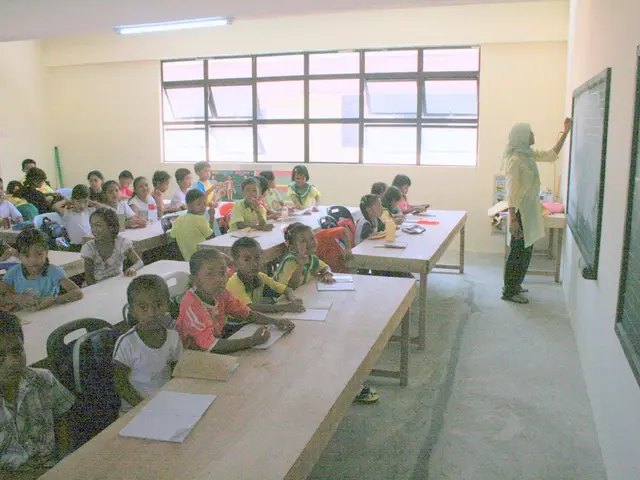Children residing in areas close to the border may face an increased risk of health issues due to ongoing sewage issues, according to the San Diego Union-Tribune.
In the South Bay Union School District, concerns about the health of students have been escalating due to the persistent presence of hydrogen sulfide, a toxic gas, in the air. The gas, a byproduct of millions of gallons of raw sewage spilling over the U.S.-Mexico border via the Tijuana River, has been linked to exacerbating asthma symptoms in sensitive individuals, particularly children.
Virginia Castellanos, a nurse working in the South Bay Union School District, has witnessed the impact of this contamination on her daughter Jade, who often misses school due to her asthma symptoms. On April 25, Jade had a mucousy and thunderous cough, and on April 28, she was diagnosed with pneumonia. Castellanos suspects the Tijuana River as the source of Jade's health issues.
Similarly, Renee Archuletta has received a notice from the school district about her son Marcus' absences due to illness. Marcus, a second-grader at Oneonta Elementary, has missed school due to worsening asthma symptoms, which his mother attributes to hydrogen sulfide odors. Another student, Jade, has also missed school due to health impacts possibly related to cross-border pollution.
Research indicates that long-term, low-level exposure to hydrogen sulfide can lead to chronic respiratory issues, which is particularly concerning for children in areas with persistent contamination. Chronic exposure to low concentrations of hydrogen sulfide has been associated with symptoms like coughing, difficulty breathing, decreased lung function, and chronic bronchitis, all of which directly impact respiratory health.
Children are especially vulnerable to environmental pollutants due to their developing respiratory and neurological systems. Although specific studies on children’s respiratory health in the context of low-level hydrogen sulfide and cross-border pollution are limited, chronic respiratory problems have been documented in populations exposed to such pollutants long-term.
Schools in the area lack the resources to gather sewage-linked data, leaving parents like Castellanos concerned about the effects of cross-border pollution on their children. The Centers for Disease Control and Prevention conducted an in-person survey in the Tijuana River Valley and found that 20% of households had their work or school performance affected.
County leaders have committed to exploring a plan to appoint a "county sewage crisis chief," upgrade air filtration systems at local schools and day cares, and launch in-depth public health and economic impact reports. The San Diego County Air Pollution Control District has collected months' worth of data on hydrogen sulfide levels, but this data does not provide enough information to assess the long-term health risks of exposure.
School absences sometimes rose after concentrations of hydrogen sulfide increased. For example, at Berry Elementary School, the average hourly reading of hydrogen sulfide levels jumped above the state threshold of 30 ppb on April 13, and absences rose the next day. However, absences don't always follow hydrogen sulfide spikes; for example, at Berry Elementary, absences peaked on March 13, with a total of 75, or 25%, even though the average hourly readings of the sewer gas were around 1 ppb on March 13 and the day before, well below the state threshold of 30 ppb.
Reports of untreated wastewater flowing across the border date back to the 1930s, and more than 44 billion gallons of raw sewage mixed with polluted stormwater and trash made their way into the Tijuana River in 2023, the most in the last quarter-century. The South Bay Union School District Superintendent Jose Espinoza expressed frustration about not having the resources to gather and analyze data or hire someone to focus on the sewage crisis.
In summary, the evidence supports that persistent low-level H2S exposure poses a risk to respiratory health over the long term, especially for children, though more targeted research might be needed to fully understand cross-border pollution impacts on pediatric respiratory outcomes. Monitoring and intervention in contaminated areas remain critical to protect vulnerable populations.
- Virginia Castellanos, a nurse in the health-and-wellness sector, suspects the Tijuana River, a source of hydrogen sulfide, as the cause of her daughter Jade's health issues, including pneumonia.
- Renee Archuletta, worried about her son Marcus' absences due to asthma symptoms, links them to hydrogen sulfide odors in the air, a byproduct of environmental pollution from the Tijuana River.
- Chronic, long-term exposure to hydrogen sulfide can lead to serious respiratory problems, such as coughing, difficulty breathing, decreased lung function, and chronic bronchitis, which directly impact mental-health through stress and reduced quality of life.
- Lack of resources forces schools in the area to rely on parents like Castellanos, who are concerned about the potential impacts of cross-border pollution on their children's education-and-self-development, personal-growth, and overall wellbeing, including skin-care and career-development opportunities.
- To address these concerns, county leaders have pledged to appoint a "county sewage crisis chief," upgrade air filtration systems, and conduct in-depth public health and economic impact reports, with more data and research needed in the environmental-science field to accurately assess the long-term health risks of hydrogen sulfide exposure.




